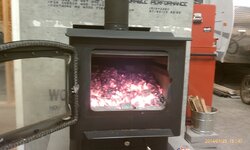We thought we could make it to spring before installing a second stove. However, the dragon in the basement is devouring the wood, and at this rate, we'll chew through our cords before February. We are fairly settled on the Englander NC-30.
Since our only experience is with the prehistoric dragon in the basement, we have some questions regarding how a new NC-30 might compare to the dragon. I know it depends on a lot of factors, but....
1. We can get no more than a 3 hour burn time in our dragon. We are now burning seasoned hard maple, black birch, and oak. Small or large loads, the stove is cold within 5 hours. Stove top temp is back to zero. I realize mileage may vary, but is there an average we can expect with regard to burn times and heat output with an NC-30?
2. We have tried BioBricks and HomeFires all-nighter logs for longer burn times. Our optimal burn on the dragon is 550-650. We need at least 10 BioBricks or 5 all-nighters to even hit 550. In either case, we can hold that for about an hour only. The fire is out and the stove is cold within 4 hours. Can we get an overnight (6-8 hours) on the NC-30? And if so, is that actual burn time and how much of that is a rapidly cooling stove?
3. We typically have to babysit the dragon, as it eats through wood and we are reloading every 2 hours. What can we expect with the NC-30? Can I leave the house for 4 hours and not come home to a cold stove?
Hoping to hear from NC-30 owners or those in the know. Thanks
Since our only experience is with the prehistoric dragon in the basement, we have some questions regarding how a new NC-30 might compare to the dragon. I know it depends on a lot of factors, but....
1. We can get no more than a 3 hour burn time in our dragon. We are now burning seasoned hard maple, black birch, and oak. Small or large loads, the stove is cold within 5 hours. Stove top temp is back to zero. I realize mileage may vary, but is there an average we can expect with regard to burn times and heat output with an NC-30?
2. We have tried BioBricks and HomeFires all-nighter logs for longer burn times. Our optimal burn on the dragon is 550-650. We need at least 10 BioBricks or 5 all-nighters to even hit 550. In either case, we can hold that for about an hour only. The fire is out and the stove is cold within 4 hours. Can we get an overnight (6-8 hours) on the NC-30? And if so, is that actual burn time and how much of that is a rapidly cooling stove?
3. We typically have to babysit the dragon, as it eats through wood and we are reloading every 2 hours. What can we expect with the NC-30? Can I leave the house for 4 hours and not come home to a cold stove?
Hoping to hear from NC-30 owners or those in the know. Thanks



